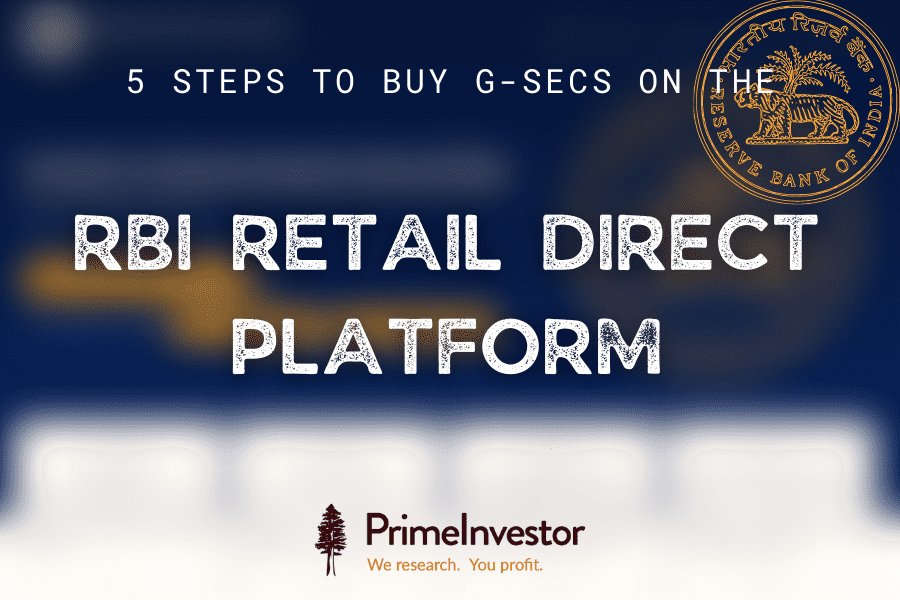After many tries, a direct platform for retail investors to buy government securities is finally up and running in India. The new RBI Retail Direct platform which was flagged off in November, offers retail investors a chance to participate in the primary market auctions of Central government and State government securities that the RBI conducts.
This is not the only platform available for buying g-secs, with brokers such as Zerodha and NSE’s goBid platform already offering a doorway to primary auctions for some time now. But the RBI platform scores as it is a completely free account, and doesn’t charge any account opening fees, account maintenance fees or brokerage on transactions.
If you have always been keen to invest directly in government bonds without having to depend on mutual funds, insurance companies or pension funds to channel your money into them, RBI Retail Direct is worth exploring.

The bidding process on RBI Retail Direct platform
If you’re used to super-quick and seamless onboarding on fintech platforms, you may find RBI’s onboarding process quite cumbersome. For us, it took quite a few tries over a number of days to finally yield results and secure a login ID and password for the primary auctions section. If you’d also like access to secondary trades in gilts (you will need this to sell the g-secs you buy before maturity date, or to track yields and prices in the secondary market) which happen in the NDS-OM (Negotiated Dealer System Order Matching) platform, that requires a separate approval process.
The platform allows you to buy into primary auctions in four types of instruments:
- Government of India Treasury Bills (T-bills): T-bills are issued when the Central government wishes to borrow for a less than one-year tenure and are issued in 91-day, 182-day and 364-day tenors.
- Government of India dated securities (g-secs): Dated g-secs called Government Stock are issued for tenures from 1 to 40 years
- State Development Loans (SDLs): SDLs are also issued for tenures from 1 to 40 years
- Sovereign Gold Bonds (SGBs)
All g-secs pay out interest at half-yearly intervals and don’t offer any cumulative option.
While institutional investors such as insurance companies or mutual funds are expected to bid on either coupon or prices to secure allotments, retail investors are allowed to bid at the cutoff yield or price discovered by the auction (similar to book-built IPOs). The portion of each auction reserved for retail investors is called the non-competitive bid window. Retail folks can bid a minimum of Rs 10,000 and a maximum of Rs 2 crore in any auction.
Once you have your username and password, here are the steps you can follow to buy your g-secs.
#1 Know the issuance calendar
Primary issues of government bonds are not available on tap. If you wish to buy them you need to keep cash ready and wait for the bond of your preferred tenor to be auctioned by RBI. This process is made somewhat easy by RBI publishing its auction calendar in advance:
- For dated g-secs beyond 1 year, RBI publishes its auction calendar six months ahead on its website here.
- For T-bill auctions it publishes a quarterly calendar on its website here
- RBI also publishes newspaper advertisements on every upcoming auction with details such as the security being sold, its maturity date and the indicative yield. These are also available in RBI’s press releases section.
#2 Decide on tenor
You have little say over the coupon on the g-sec you’ll be buying through the RBI auction. What you do have is the choice on maturity, so it is best that you decide based on the tenor of the bond. So, how do you decide whether to participate in the auction of 91-day T-bills, 5 year dated g-secs or 30-year g-secs? You should consider the three following factors:
First, given that g-secs often entail a lock in until maturity and don’t offer any time exit (secondary market liquidity is poor in most g-secs), it would best to match the maturity of the g-sec you’re buying to your need for cash or financial goals. You can approach this as you do debt mutual funds. If you have emergency money you can park for 3 months or 6 months, you can buy a 91-day or 182 T-bill. If you’re looking for regular income lasting 30 years, you can participate in a 30-year g-sec auction.
Two, your choice of tenor should also depend on where we are in the interest rate cycle. If we’re at a low point in the economy’s rate cycle, it makes little sense to lock into longer tenor bonds for 10, 20 or 30 years as you’ll be stuck with low interest rates for the entire period. Your bond can also lose value in the secondary market if rates move up. If you’re at a high point in the rate cycle, it makes sense to lock into longer tenor g-secs so that you can sit back and earn assured returns at high rates for long.
Yes, this calls for some market understanding on your part. But here’s a way to gauge where we are in the rate cycle without getting in too deep – look at RBI’s repo rates and the market yield on the 10-year g-sec. In the last 20 years, RBI’s repo rates have moved between a low of 4% and a high of 8%. The 10-year g-sec has swung between 5.8% and 9.1%. Today, with the repo rate at 4% and the 10-year g-sec at a yield of about 6.34%, we are closer to the bottom end of the rate cycle. You should thus be looking at shorter tenor g-secs such as T-bills and 1 year g-secs right now.
Three, if you’re able to, you can also consider the shape of the yield curve (a line graph plotted on yields offered by bonds of different tenures) to decide what to buy. Usually, longer tenure bonds offer higher rates than short tenure ones to compensate for time value of money and default risk. But the incremental returns you get for taking on a higher lock-in may not be uniform. On December 9 for instance, a 1-year g-sec (364-day T-bill) offered a yield of 4.24%, the 3-year g-sec offered 5.06%, the 5-year g-sec 5.69% and the 10-year g-sec 6.34%.
By opting for a 5-year tenure instead of 1-year you earn 145 basis points in extra interest. But by choosing a 10-year g-sec over 5 years there’s only a 65-basis point benefit. This suggests that a 5-year g-sec may offer a better balance between returns and rate risk.
#3 Choose your instrument
While your selection between T-bills and dated g-secs will depend on your choice of tenure, you will also have to make additional calls on whether to buy fixed or floating rate government bonds and whether to buy Central government bonds or State government ones.
Theoretically, floating rate bonds are a better bet when you’re closer to the bottom of a rate cycle as you get to earn higher interest receipts when rates rise. But whether government FRBs (RBI short-form for Floating Rate Bonds) are really attractive relative to fixed rate bonds will depend on how the ‘floating rates’ of the bond are determined.
Recently, for instance, the RBI issued FRBs maturing in 2028, where the coupon or interest rate was based on a 64-basis point spread over the weighted average yield of the last three 182 day T-bill auction. The interest was to be revised half-yearly based on prevailing yields. Essentially, given that 182-day T-bills were offering 3.4% at the time of this auction, the 7-year FRBs would pay you a coupon of just 4.04% to start with. This was much lower than the fixed rate offered by 5-year bonds at the same time, which offered 5.7%. At this point in time therefore, FRBs were less attractive than fixed rate bonds.
If you would like to bump up the yield you’re earning on government bonds without taking on too much added risk, SDLs or state government bonds offer an alternative. Recently, for instance, 10-year plus SDLs were auctioned at yields of 6.9-7% against yields of 6.3-6.4% prevailing on central government bonds.
However, SDL auctions tend to be occasional and the State government whose bonds you prefer may not conduct auctions at a time of your choice. SDLs are also priced based on the financials of the State which is issuing them and you need to analyse data such as the state’s GDP growth prospects, its latest fiscal and revenue deficit position, its ability to raise tax revenues and its borrowing plans, before deciding on the right bond. Owning a basket of SDLs through the fund route may present a better alternative, as we have explained in an earlier article on the SDL bond opportunity.
#4 Gauge liquidity
A key constraint for retail investors looking to own g-secs in India is lack of secondary market liquidity. Therefore, while bidding in the primary market auctions, it best to be prepared to hold the bond until maturity. However, if you really want to keep your options open on premature exit, it would be prudent to run a liquidity check on NDS-OM.
The NDS-OM is the secondary market platform where all outstanding gilts are traded and their trades reported. Before bidding in primary auctions, you can log on to this platform to broadly understand how yields for gilts of different tenors are trending on any given day. During market hours, live market quotes can be tracked here: https://www.ccilindia.com/OMHome.aspx
On any given day, much of the trading volumes on the NDS-OM are hogged by the 10-year g-sec, with 5-year and 3-year g-secs coming next. T-bills and SDLs tend to register sporadic trading volumes compared to 5 and 10-year g-secs. More recently issued bonds tend to be actively traded while older ones see hardly any trades.
For retail investors, the problem is compounded by the fact that they cannot trade in the Regular market segment of NDS-OM and can only trade in the Odd Lots segment. The same bond can trade with different pricing and liquidity in the Regular and Odd Lots market. You can find a list of all outstanding government bonds whether traded or not, here. Bonds with a higher outstanding quantity are likely to be more liquid.
#5 Place your bids
As a retail investor, you are not required to know how to price a bond when bidding in RBI’s auctions. But it is still useful to understand how auctions are conducted and the g-secs finally priced.
T-bills in RBI auctions are usually offered at a discount to their face value and redeemed at face value. The difference represents your returns. To cite a simple example, if a 182-day T-bill with a face value of Rs 100 is offered at Rs 98, your yield on it is 4.09 per cent (2/98 * 365/182).
On dated g-secs (g-secs with maturity above 1 year), RBI conducts both yield-based auctions and price-based ones. New issues of g-secs are generally sold through yield-based auctions. Here, the RBI fixes a maximum coupon rate that it would like to offer on the issue and invites bids from institutional investors on the coupon rate that they’d like to demand, subject to the ceiling. Like in book-built IPOs, the lowest coupon at which an auction gets fully subscribed is taken as the cutoff yield and becomes the actual interest rate on the bond.
Sometimes RBI also re-issues older g-secs instead of rolling out new series. In such cases, the bidders are required to bid the prices at which they’ll buy the bonds. The highest cutoff price at which an issue gets subscribed is treated as the cutoff price and also decides your yield on the bond.
As a retail investor, you are required to bid at cutoff yields/prices decided by institutions and have no say in the pricing of gilts. You will be allotted bonds at the weighted average yield that emerges from competitive bidding; thus, expect the cutoff yield to be your return.
Because you have no idea of the actual price or yield at which an auction may conclude at the time of placing your bids, RBI provides an indicative yield or indicative price at which you get to place your bids. Once the auction is concluded and the actual yield and pricing of the bond is known, the excess amount you pay (the amount collected upfront is always based on the maximum coupon) is refunded into your account.
When you log on to RBI’s Retail Direct Platform, the dashboard displays all the T-Bills, G-secs and SDLs currently open for primary market subscriptions. It offers details such as the type of security, maturity date of the security, issuer (Central or State government), the issue size and amount reserved for non-competitive bidding by retail investors and indicative yield (%).
On filling in the bid amount (in multiples of Rs 10,000), the site automatically throws up the indicative settlement amount that you are expected to pay. For instance, on December 8, the portal was open for bids on the 4.56% g-sec maturing in November 2023 which was being reissued. The retail portion reserved for non-competitive bids was Rs 100 crore. The bond had a clean price (i.e., without factoring in interest accrued) of Rs 99.54 and an indicative yield of 4.8%.
Placing a bid for Rs 10,000 worth of bonds threw up an indicative settlement price of Rs 10,271. Based on the final price that is decided by the auction, the excess will be refunded and you will be allotted the bonds in your Direct account. On maturity, the bonds will be automatically redeemed and the proceeds credited to you.
The RBI Retail Direct platform is a good route to directly own Central and State government bonds, but it does call for some understanding on the tenure to bid and when to bid. The tips explained above are good guidelines for you to approach these two key factors, and don’t require you to have a very detailed understanding of the way rates or the bond markets work.
Even so, a natural question that may follow this is whether you can use the RBI Retail Direct platform to invest and hold a few choice g-secs, or whether a gilt mutual fund would be easier. We’ll take up that discussion in a later article!








17 thoughts on “5 steps to buy g-secs on the RBI Retail Direct platform”
can a NRI open account on RBI direct platform and participate in bond yield
Only Non-Resident retail investors eligible to invest in Government Securities under Foreign Exchange Management Act, 1999, with valid KYC documents and a domestic Rupee account with banks can open an account
Non-Resident retail investors eligible to invest in Government Securities under Foreign Exchange Management Act, 1999, with valid KYC documents and a domestic Rupee account with banks can open an account
Hi Aarati,
I read that some things have happened recently in the Gilts auction space – devolvement, cancellation etc.. Couldn’t make much of it. Anything we should know?
Thanks
RBI rejects bids from institutions or devolves auctions if it finds the yields bid too high. As a retail investor there’s not much you can do in such cases. The auction you bid for may not go through if RBI refuses bids. Else its not very relevant.
Thanks
Dear Madam,
Your article is very clear.
but really it is very touch to understand in RBI website.
i opened the account with RBI.
1. On 28th Dec 2021 – GOI Floating rates bonds – 2028 – 4.6 % Yield.
2. 364 DTB – Offers – 4.21 % yield.
i have two questions.
1. Whether in floating rates bonds rates interest % will change every year and my yield also changes at maturity.
it my understanding is correct.
2. In the above which one is best for 1 year period. i can understand lock in there in floating bonds till 2028.
kindly suggest.
Yes interest on these bonds will change every year based on the yield on the t bill. Currently these yields are not attractive. Floating rate bonds are not traded frequently so your money will get locked untill 2028. Pl avoid these bonds now
Thanks for your input.
Thanks for the well explained article. i have one question. Can i use long dated G-sec as replacement of Annuity since G-Sec rates are better then annuity rates
Yes you can. However good to time the purchase to a higher level of interest rates or to use a laddering approach where you will buy at different levels. Plan to write on this
Thank you for the artice.
probably we can start buying 20-30-40 year bonds when rates go up (8%+ ??)…
One tip: Without logging into the RD portal, the bonds on issue can be seen here:
https://www1.nseindia.com/products/content/debt/ncbp/ncbp_issues.htm
Yes better to lock in at higher rates. Thanks for the tip 🙂
Thanks Aarati for the, as usual, lucid write up. Keenly awaiting your “later article”, where I am sure the significant angle of taxation will be discussed.
Good day!
Will follow soon!
Hi Aarti. Thank you for a well explained article. I have a question on taxation of g-sec. If held for more than 3 years, can we get indexation benefit in computing long term capital gains?
No. Interest recd on gilts is treated as current income and taxed at the slab rate, irrespective of holding period
Comments are closed.